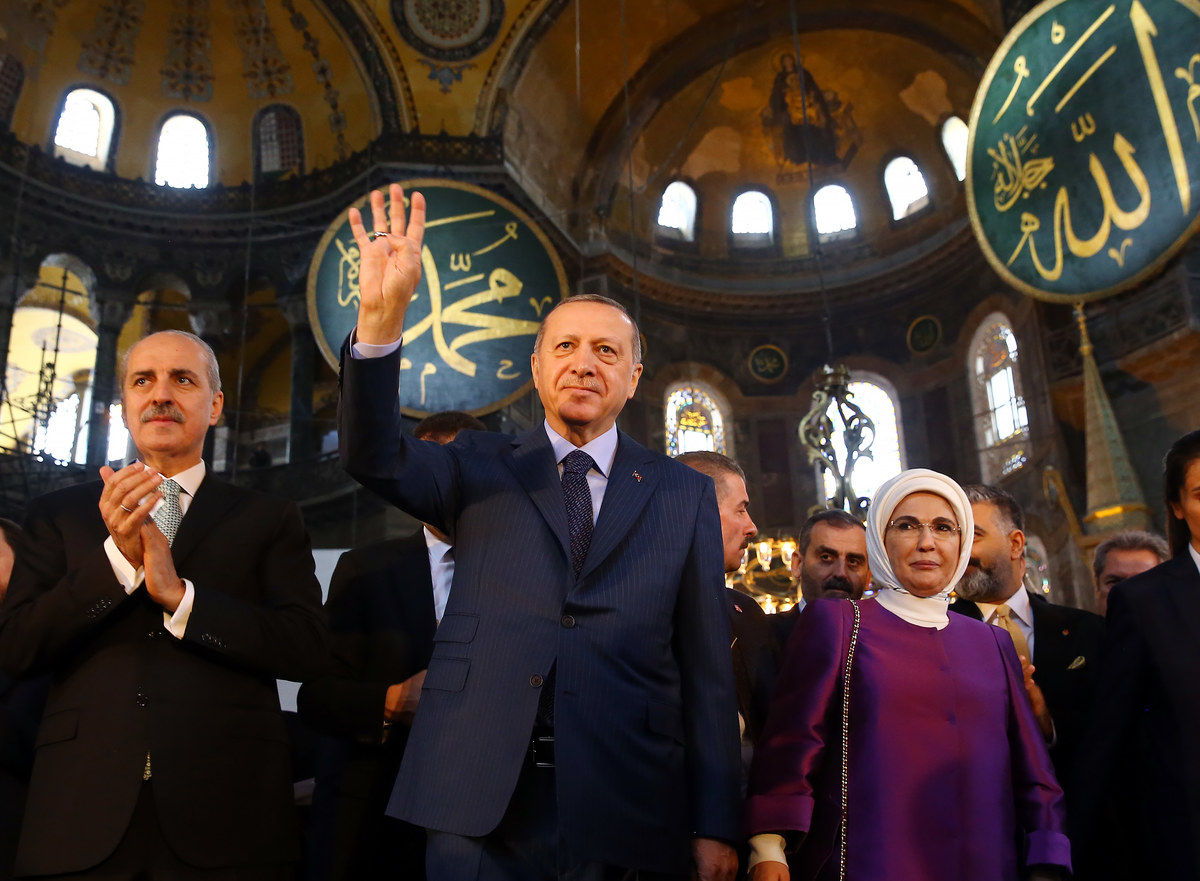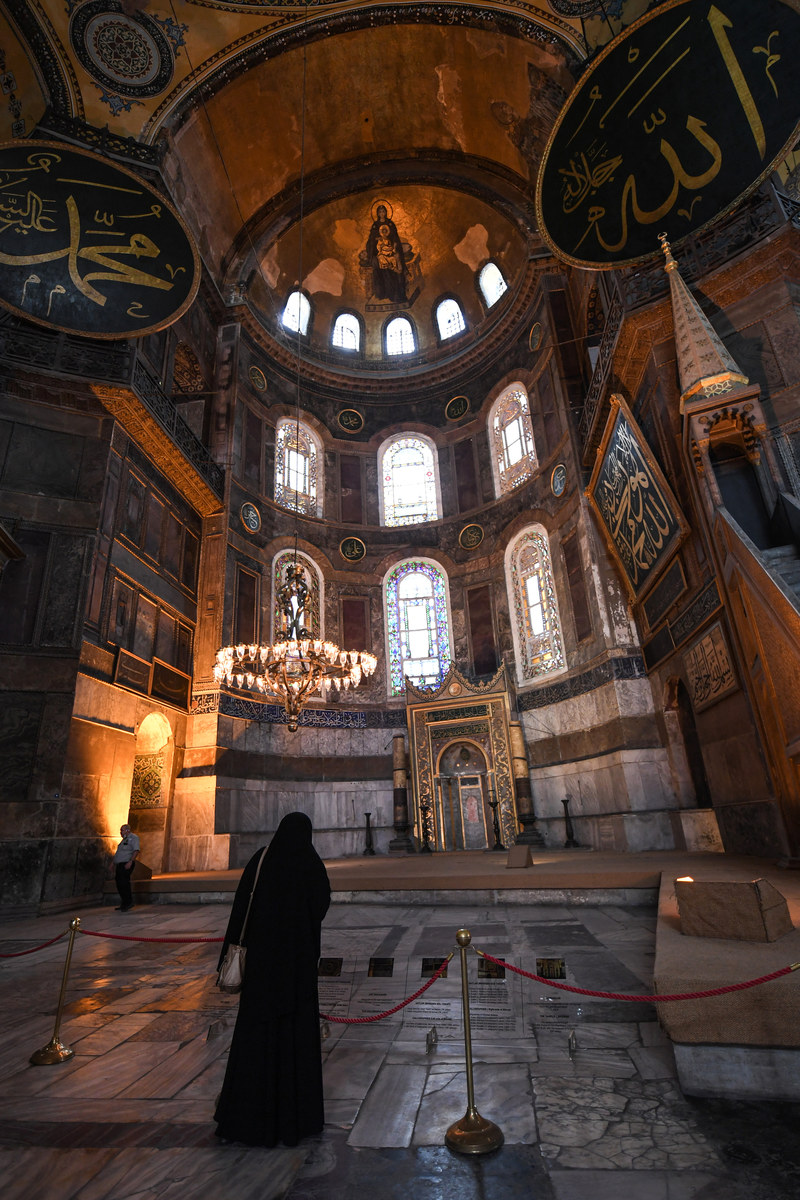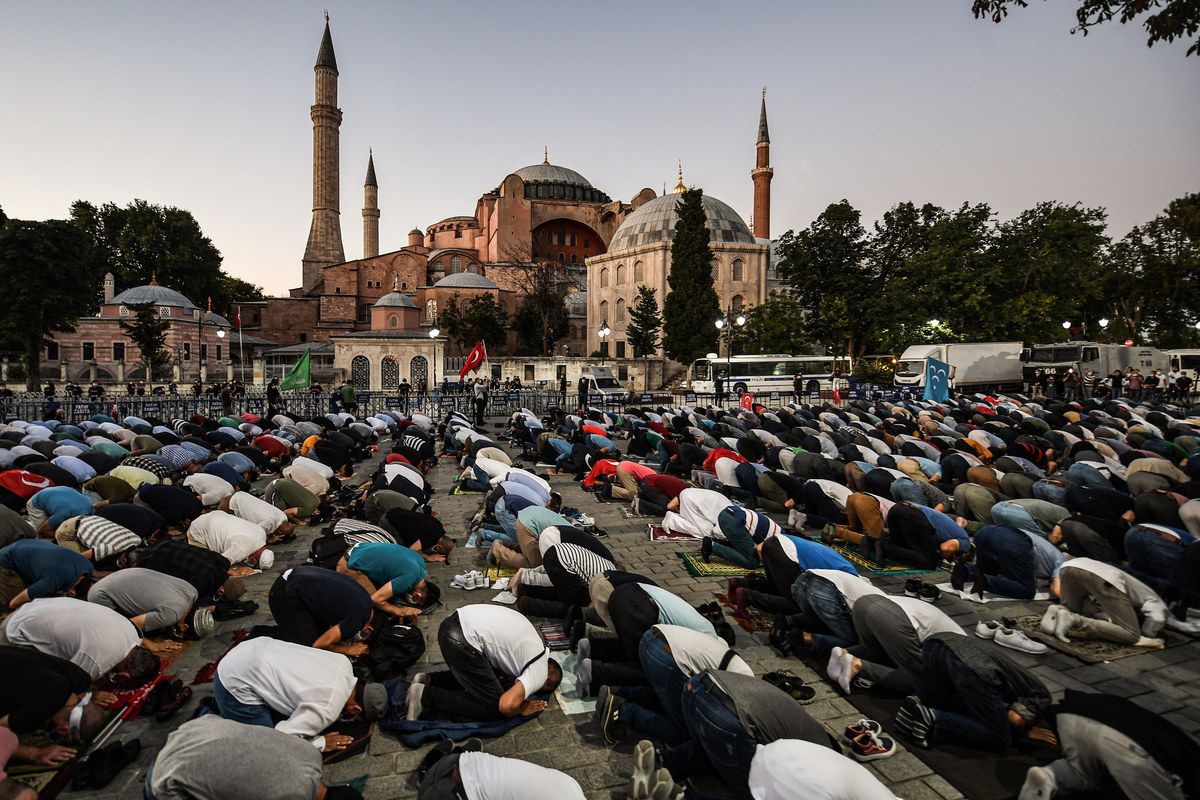By changing the status of Haghia Sophia, Erdogan is playing to extremists

https://arab.news/rfw8z
RIYADH: “Did you take part in the plunder of Istanbul?” So runs a popular saying in the Turkish city, a reference to the plunder and killings endured by the city’s population at the hands of the Ottoman army after it was conquered by Mehmed II in H 857 (1453 AD). The pillage, which reflected the nature and practices of the Ottomans, continued throughout their rule.
“A leopard does not change its spots,” as the saying goes, no matter how much time passes. What the current Turkish government is doing under President Recep Tayyip Erdogan against the Arab world is a reflection of old Ottoman habits, rooted either in imperial dreams or the intention to economically drain states that have come under the sway of the Turkish Republic. It does so by taking advantage of the ideology of extremist groups and instigating intra-Arab conflicts, by arousing religious emotions that incite violence.

The true intention of this move was to win over extremist Muslims by emphasising an image that stirs their emotions yet hides a reality that is far from the Islamic spirit. (File/AFP)
All the Turkish government’s actions with a religious dimension attempt to bolster support for its positions and portray it as a bastion of Islam.
It is manipulating the emotions of its own people who have been inveigled into confusing this Islamic facade, whose ornaments are piety and dignity, with reality. For this reality is far from ideal as Turkey pursues close relations with Israel and commits crimes against innocent Arabs either by using them as mercenaries, by conducting military operations on their territories and laying hands on their countries’ resources, and by exhausting their economies by demanding tributes from them.
The Turkish government’s game has finally been exposed yet it continues to play on people’s religious sensitivities and feelings.

The Council of State, the country's highest administrative court which on July 2 debated a case brought by a Turkish NGO, cancelled a 1934 cabinet decision and ruled the UNESCO World Heritage site would be reopened to Muslim worshipping. (Ozan Kose/AFP)
Last week the Council of State, Turkey’s top administrative court, unanimously voted to nullify the Turkish government’s H 1353/ 1934 AD decision to convert Hagia Sophia from a mosque to a museum. This amount to a flagrant manipulation of emotions, especially after the call for prayer was sounded and prayers were allowed at the Hagia Sophia.
The true intention of this move was to win over extremist Muslims by emphasising an image that stirs their emotions yet hides a reality that is far from the Islamic spirit.
However, politicians are playing a dangerous game when they try to change or twist history, for when the facts are revealed they will backfire on those politicians. Turkey is a living example of a government that distorts history to serve its political interests.
Regarding Hagia Sophia, there are two important historical questions, the answers to which reveal what the Turkish government is really doing.
First, since the days of the Prophet Muhammad (peace be upon him), under the wise Caliphs, and afterwards the Umayyads and Abbasids, Muslims never infringed on the sanctity of the places of worship of the People of the book (Christians and Jews) in the countries they conquered before the Ottomans.
Second, what were the conditions for sounding the call to prayer after the conquest of Constantinople during the days of Mehmed II and the conversion of Hagia Sophia into a mosque?
During the days of the Prophet, Mohammed bin Saad (who died in H 230/845 AD) mentioned in his book “Al-Tabaqat Al-Kabir” that the Prophet wrote to the Bishop of Bani Harith bin Kaab and the bishops of Najran, their priests, monks and followers that they “keep all that is in their hands whether little or many, including their property, prayers, or monks, all under the protection of God Almighty and his Prophet (PBUH), no bishop is to be removed from his post, or monk from his monastery, nor priest from his church” [Reviewed by Ali Mohammed (Cairo: Al-Khanji Boosktore, 2001)].
What the Prophet wrote became a tradition and law that all Muslims should abide by, to live with others while respecting their religious rituals, places of worship and religious feelings.
After the Prophet, the wise Caliphs followed this tolerant and benevolent tradition. Caliph Omar bin Khattab followed suit with what is known as the “Covenant of Omar” for the people of Jerusalem: “In the Name of God The Most Gracious, The Most Merciful, This is an assurance of peace and protection given by the servant of Allah Omar, Commander of the Believers to the people of Ilia' (Jerusalem). He gave them an assurance of protection for their lives, property, church and crosses as well as the sick and healthy and all its religious community. Their churches shall not be occupied, demolished nor taken away wholly or in part. None of their crosses nor property shall be seized. They shall not be coerced in their religion nor shall any of them be injured.”
The true intention of the Hagia Sophia conversion was to win over extremists to Erdogan’s side by stirring their emotions but hiding a reality that is far from the Islamic spirit.
Talal Al-Torifi
Omar wrote a similar covenant for the people of Lod, while Ayyadh bin Ghanam wrote a similar covenant for the people or Ar-Raqqah and the Bishop of Odessa. When Khalid bin Al-Walid conquered Damascus, he wrote to its people: “In the name of Allah, the Beneficent, the Merciful. This is given by Khalid bin Al-Walid to the people of Damascus. When the Muslims enter, they (the people) shall have safety for themselves, their property, their temples and the walls of their city, of which nothing shall be destroyed. They have this guarantee on behalf of Allah, the Messenger of Allah, the Caliph and the Muslims.” [Ahmed bin Abi Yakoob, Tarikh Al-Yakoobi, reviewed by Abdul Amir Mhanna, (Beirut: Al-Aalami Lil Matbouat, 2010) Said bin Batriq “Afticius,” Al-Tarikh Al-Majmou’ Ala Al-Tahqiq Wal Tasdiq (Beirut: Jesuites Print\eing Press, 1905).]
This was the benevolent, civilized, and noble behavior of the Prophet and his successors.
In contrast, when Mehmed II entered Constantinople with his Ottoman army he planted fear and terror among its inhabitants, and allowed his army to loot the city for many days.
Hagia Sophia is a Christian church that was built between 532 AD and 537 AD during the reign of Emperor Justinian I, and remained so until the Ottomans conquered Constantinople, when Mehmed II challenged the teaching of Islam by converting the church into a mosque, taking advantage of his crushing victory over the city and its people.
History books are unanimous that Mehmed II, when he first entered the city, had already ordered converting it into a mosque and holding the first prayer inside it. This was an abuse that flagrantly contradicted the instruction to respect the People of the Book as it was cited in the letter of Prophet Muhammad and his successors.
To be sure, many historians, whether Turks or some Arabs, mention this event with pride, though in reality it is shameful, because it does not reflect Islamic morals. The historian Albert Ortelli wrote: “So Hagia Sophia, which was the greatest place of worship in the Christian world, had become a great place for Islamic worship. No building in Western Europe was more charming than Hagia Sophia. Prior to the construction of the great churches during the Renaissance, Hagia Sophia was the spotlight of Christians everywhere. This explains why Hagia Sophia's conversion into a mosque was a crucial matter.
“In the same sense, the behavior of the Turkish Republic after 1930 was extremely important in political and cultural terms when it turned this place of worship into a museum, after it was a cause of discord between people for centuries.” [The Ottomans Rediscovered, translated by Bassam Chiha (Beirut: Al-Dar Al-Arabiya Lil Ulum Nashiroun, 2012, 77)].
Ortelli’s words provide us with an accurate description of the sensitivity of Turks over the violation of the sanctity of the Hagia Sophia church. The only way out for the government was to turn the structure into a museum that was not a place of worship either for Christians or Muslims.

The sixth-century Istanbul building, a magnet for tourists, has been a museum since 1935, open to believers of all faiths thanks to a cabinet decision stamped by modern Turkey's founder Mustafa Kemal Ataturk. (Ozan Kose/AFP)
Mohammed Harb, in his book on Ottoman history and civilization, revealed extremist Islamic passion by portraying the matter as a moment of pride, saying: “Al-Fatih (Mehmed II) was legally entitled — as long as the city was taken by force — that he be, on behalf of the conquering army, the owner of everything in the city, and he also had the right to convert half of the churches into mosques and leave the other half to the people of the city as an expression of his generosity. This is how monasteries like Jokalija, Hagia, Leps, and Kira, remained in the hands of the Byzantines” [(2nd Print (Damascus: Dar El-Qalam, 1999, 75) ].
Compulsive slavery was not a familiar concept to Muslims before the capture of Constantinople, for it is not acceptable to treat the people, their properties and their places of worship as the property of the Sultan, contrary to what Mohammed Harb claimed in his book.
Erdogan has gone backwards in order to emphasize that a leopard cannot change its spots. He is trying to win over Muslim hearts across the world by holding prayers at Hagia Sophia and converting it into a mosque, even though such a move does not represent Islamic values, which prohibit the coercing and insulting of the People of the Book.
Turkey has little interest in winning over European minds. Erdogan’s real attention is focused on the Arab and the Islamic world and is playing to the emotions of Muslims and Arab in hurting the feelings of Christians and making them watch their church forcibly transformed into a mosque.
The Turks do not have the right to vote in such a decision, under laws that guarantee the rights and sentiments of the people worldwide. This was not only dictated by international law, but mainly by the principles of Prophet Muhammad, his companions and moderate Islamic teachings down the ages.
As for the document which claims that Hagia Sophia was part of the Waqf of Fatih, it is for sure part of the games in which history is forged and used. It is not difficult to forge such a document, especially given that the document is not compatible with historical facts. For Fatih, when he first set foot in the city, announced the conversion of Hagia Sophia into a mosque, then when did he have time to buy it and set it as Waqf? For him, it was a fait accompli.
The Hagia Sophia affair does not represent us as Muslims worldwide, just as we are fighting against what is being promoted by the Spanish government in its ownership of the Mosque of Cordoba. It is unimaginable for anyone to sell a house of God. Hagia Sophia is viewed by Christians the way the Mosque of Cordoba is viewed by Muslims.
-----------
• Talal Al-Torifi is a Saudi academic and media professional







































